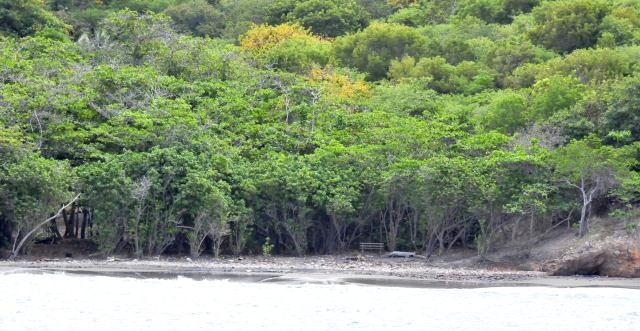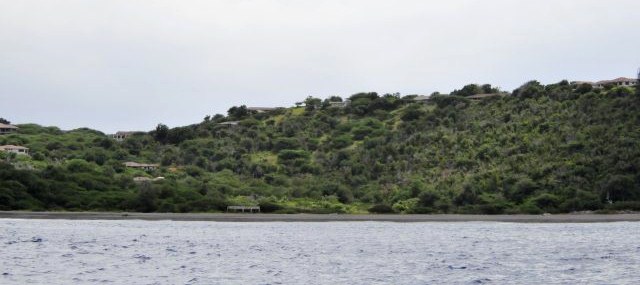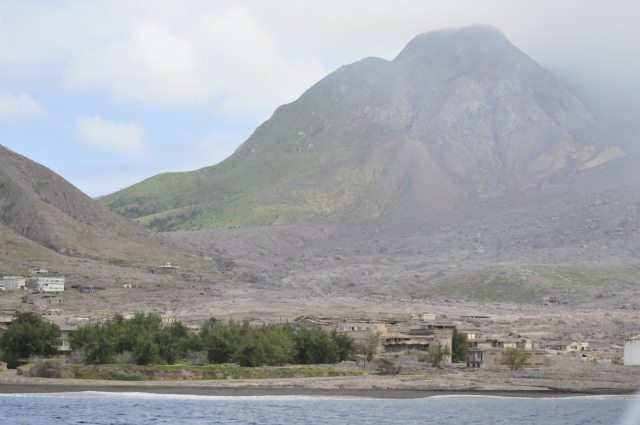A Spuddle

|
A Spuddle Down the West Coast
West Troy
  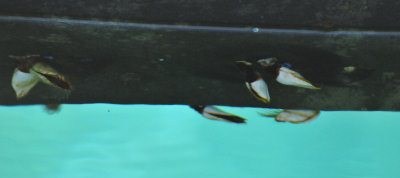 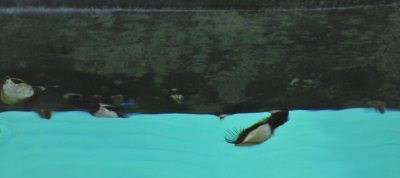 The closest look we
could get of Plymouth was to go on a boat tour - off we went on Giant Stride and her resident soft
barnacles
   We had wondered
why the only 'One Careful Owner we had seen all day yesterday was an outboard engine on the quayside. Troy told us why. HRH
Prince Charles visited the island two and a half years ago and every car
wreck had been gathered up and hidden behind the
prison. Trouble was he decided to come by yacht and anchored in Little
Bay he got the pleasure of studying them for a full
week. The prison itself has sixteen guests, there is a murder on average
every four years and the last guest to arrive - about two years ago - is in
for stealing his neighbours goat.
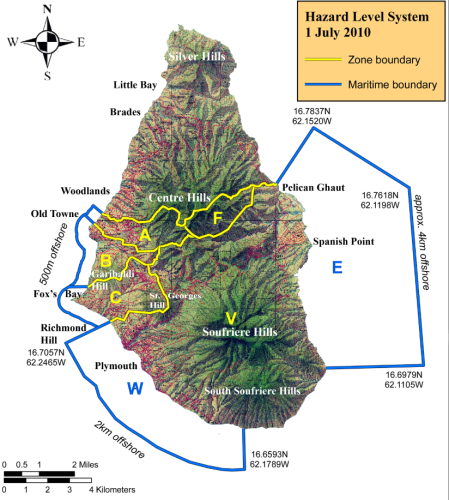 As we went along
Troy taught us about zones
 Zone A:
South of
Nantes River, including, Salem, Hope, Frith, Flemmings, parts of Olveston and
Old Towne, the upper part of Happy Hill and extending five hundred miles out to
sea. Zone B: Iles Bay,
Belham, Waterworks, parts of Old Towne, the lower part of Happy Hill and
extending 500 m out to sea. Zone C:
Cork Hill,
Weekes, St Georges Hill, Foxes Bay, Richmond Hill, Delvins and extending 500 m
out to sea. Zone F:
Corbett
Springs, Locust Valley. This zone is dedicated to farming and is defined by
NDPRAC. Zone V:
Soufriere
Hills, South Soufriere Hills, Plymouth, Lee’s, Harris, Spanish
Point. Zone E: Approximately 4 km offshore between Roches Yard and Spanish Point, decreasing to 2 km offshore from Spanish Point to Pelican Ghaut.
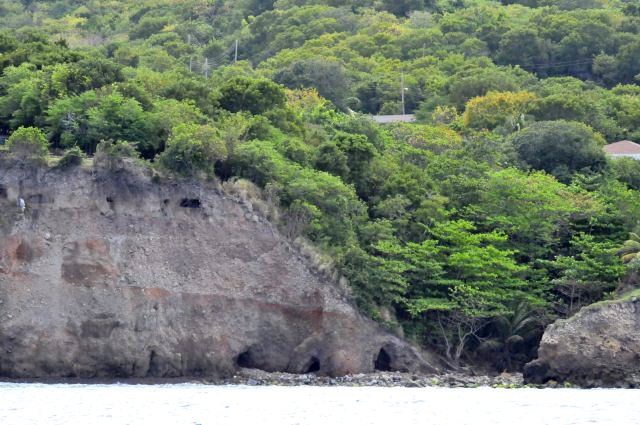 Nantes River marks the beginning of Zone A
Lime Kiln Beach - start of Zone B. In rough seas the sand gets washed away leaving pebbles, seas settle back the sand comes
Fox's Bay - start of Zone C
Troy told us that Fox's Bay - was just being developed. If you go into the houses here you would see kitchen floors half tiled, the rest in a neat pile, glue at the ready. The same for the bathrooms.
 The Belham Valley where we were yesterday in the old river bed
The sand sifter, just seen on the picture above on left. One of the few feral cows who live in the area seen on the new beach hundreds of yards in front of where the old one was. Troy says its funny to see how they keep the 'posh' property grass well manicured, just as if a gardener is still employed - and he has seen them drinking from the swimming pools.
The houses to the right of the valley were / are known as "The Beverley Hills", most expensive on the island
The last house (overlooking Isles Bay) you can legally live in - there is no danger from the volcano, but no roads to safely leave by if a flow begins. First to evacuate in a warning sounds
 The MVO (own blog - Volcano) looking out from Flemings on the Centre Hills
Start of Maritime Exclusion Zone, also marks end of Zone C
Richmond Hill, looking so normal - white terrace were condominiums recently renovated
House at front - Dr TM who ran the medical school, left for St Martin. House on right belonged to the pop star Arrow. Troy says once the roof goes, the houses decline very quickly.
The dramatic change from green to sepia as
we close on Plymouth, the 'smoke' is an ash cloud from the active
volcano
 Plymouth (own blog)
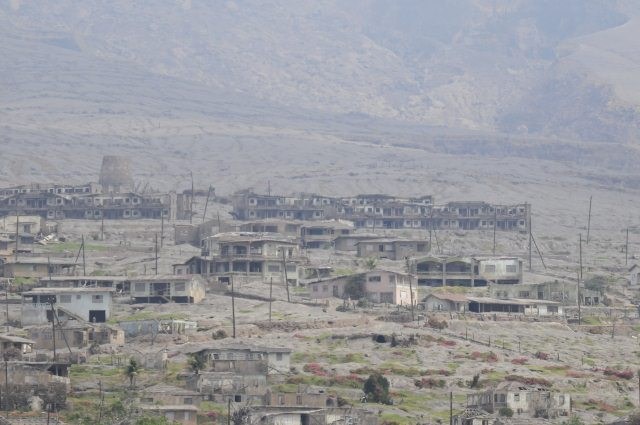 Just one photograph at this point. Buildings at top in front of Sugar
Mill is the once prestigious Medical School - no
colour adjustment needed for effect
  Troy pointed out the Lime Kiln, built by
the French in the 1600's, once hidden, now exposed through erosion. The mood on
the boat was very sober, given the sights we had seen. Hard to enjoy the beauty
of the rocks, showing how the
island was originally formed. I commented on how few birds we had
seen and Troy said there was major problems with acid rain, generated by the ash
in the air. Fishing is now far out to sea for cod, just a few scratchy sized
fish on the north and the occasional swarm of bait fish off Little Bay that
brings in the Frigate bird, tropicbird and pelican. The beautiful dive sights
have been destroyed as the coral has been poisoned and died. The only real dive
sight is up north of Little Bay off Rendezvous Bluff, but the swell often
stops that happening. After running a business here for six years, owning a
property for eight, he is seriously considering Florida. The volcano has changed
the weather pattern, the area around the Soufriere Hills was once desert like,
now so much rain and windier. The tectonic plates are grinding together,
moving the volcano an inch north per year. A while ago a couple bought a
house on the beach on the southern tip of the island, hopeful that in five, ten,
fifteen years time, they will own high value real estate and made it rich.
However, no one is sure how it will pan out. Those with mortgages mostly gave
back their houses. Those who owned, who knows and will they ever be insurable. I
asked about hurricane insurance. It cost $2,500 per year to
insure your roof, $5,000 to put a new one on, so few bother as
damage occurs on average, every fifth year. Some say those who left
were traitors to their land, others shrug sadly. Too hard to judge, only
admiration for those who stay.
 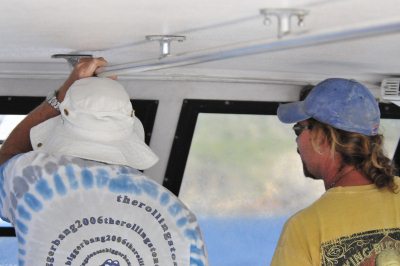 Troy impassioned and skippers
talking.
ALL IN ALL VERY EMOTIONAL TO
SEE
. .
|
